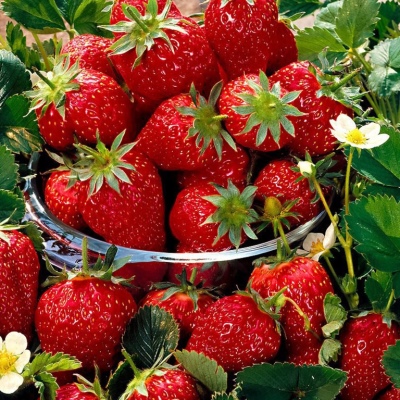
- Authors: FGBNU North Caucasus Federal Scientific Center for Horticulture, Viticulture, Winemaking
- Taste: sweet and sour
- The size: large
- Weight: 12 g
- Yield: 19.7 t / ha
- Repairability: No
- Ripening terms: medium
- Appointment: universal
- Description of the bush: medium, semi-spreading
- Berry color: light red, shiny
Gera is a strawberry variety bred by the North Caucasian Federal Scientific Center for Horticulture, Viticulture and Winemaking. This is a medium-ripening strawberry. It can be grown both for personal use and for sale.
Description of the variety
Hera strawberry bush is compact and semi-sprawling. Its height is 10 cm, peduncles are long, located at the level of the leaves or higher, the leaves are green, rounded. A feature of the variety is the ability to lay flower buds in the heat or on a long daylight hours.
Ripening terms
Hera is a medium-ripening, non-refurbishing variety. The flowering period is in spring and summer.
Yield
The strawberry productivity is 19.7 tons per hectare.
Berries and their taste
The berries of this variety are light red, shiny, smooth, regular in shape, and have a short neck. The size of the berries is large, their weight is about 12 g. The taste of the fruits is sweet and sour, according to a 5-point system, taste properties are estimated at 4.2 points. The pulp is dense, orange-colored, with a pronounced aroma. The fruits can be used both for fresh consumption and for preparations.
Growing features
It is recommended to contain Gera strawberries in the North Caucasus region. The plant belongs to the winter-hardy species. The variety tolerates a snowy winter well, but in the months with little snow at a temperature of 12-17 degrees, the bushes can freeze out. Watering is carried out in the same way as for other varieties of strawberries, but on dry days additional moisture is required.




Site selection and soil preparation
Before boarding, use a few guidelines:
- the site should be sunny or with light shade;
- if possible, plant the plant on black soil, in gray soil or in sandy loam: these types of soil retain moisture and contribute to good aeration;
- refrain from planting in clayey places: clay impedes the flow of air;
- groundwater must flow at a depth of at least 60 cm;
- two weeks before planting, dig up the bed, add rotted manure, wood ash and lime.

Pollination
The Gera variety has bisexual flowers, which means that it belongs to the self-pollinated varieties.
Top dressing
The culture needs fertilizers in autumn and spring. Autumn dressings provide a good wintering, while spring ones help to gain strength for the new season. The amount of fertilizer depends on the size of the berries. In the spring, nitrogen compounds are usually used, such as manure or bird droppings. In the fall, phosphorus-potassium mixtures are suitable.
Additionally, the bushes can be fed before flowering, especially during this period potassium is relevant. Boron formulations are suitable during flowering. You can fertilize the plant during the period of berry growth. In this case, a mullein solution with the addition of wood ash is used.

One of the important techniques in strawberry care is feeding. Regular fertilization guarantees a rich harvest. There are several different ways to feed strawberries, and each of them is designed for a specific period of plant development. During flowering, fruiting and after it, feeding should be different.

Diseases and pests
The Gera variety is highly resistant to diseases and pests. However, preventive measures will not be superfluous. It is enough to carry out a double treatment of the bushes with insecticides during the season. You should also regularly loosen the soil, dig up weeds, and trim the mustache.

Strawberries are often subject to many dangerous diseases that can seriously undermine their condition. Among the most common are powdery mildew, gray mold, brown spot, anthracnose, and verticillosis. Before buying a variety, you need to inquire about its disease resistance.
Reproduction
As a rule, strawberries are usually bred with a mustache, and Gera is no exception. Rosettes and roots develop on the mustache. When they are firmly rooted, the shoot dries up, and then a new specimen is separated from the mother bush.
You can propagate the plant by dividing the bush. To do this, choose strong adult specimens with a developed root system. Dig out a bush with an earthen clod, untwist the roots with your hands and divide the bush into several parts. Transplant the resulting shares to new sites.
Reviews
Hera's strawberry is highly appreciated by summer residents. They are attracted by the universal purpose of berries, as well as uncomplicated care. The bushes are distinguished by a fruitful harvest and tolerate hot weather well.



















































































